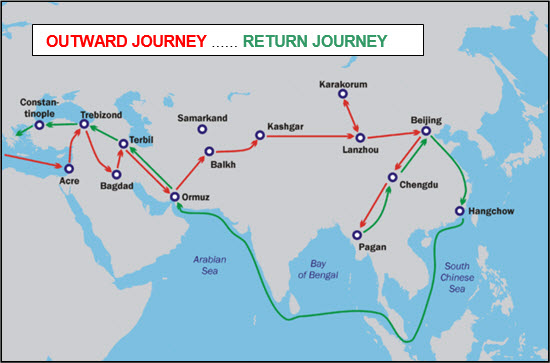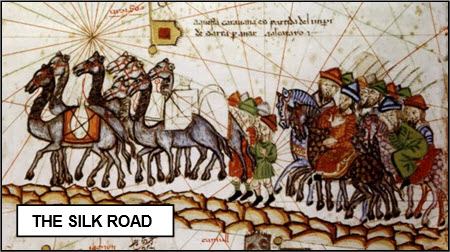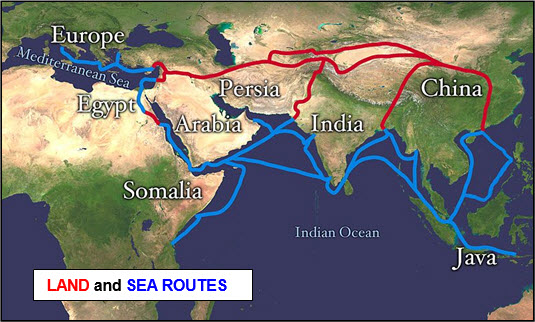


MARCO POLO c1254 -
Including:
The Silk Road

xxxxxMarco Polo was born in
Venice. In 1260 his father and uncle made a journey to the Court of
Kublai Khan in China. They were well received and returned after a
three-
 xxxxxMarco Polo, the merchant and adventurer who was destined
to become one of the world's greatest travellers, was born, it is
believed, in Venice in about 1254. The work based on his travels, Il Milione or, in English, The
Travels of Marco Polo, became a geographical classic,
though it was not without its critics regarding the matter of
accuracy.
xxxxxMarco Polo, the merchant and adventurer who was destined
to become one of the world's greatest travellers, was born, it is
believed, in Venice in about 1254. The work based on his travels, Il Milione or, in English, The
Travels of Marco Polo, became a geographical classic,
though it was not without its critics regarding the matter of
accuracy.
xxxxxLittle is known about his
early life. In 1260, when he was about six, his father, Nicolo, and
his uncle, Maffeo, both successful Venetian merchants, set out on an
overland journey to China. They crossed the arid plains of central
Asia and eventually arrived at the court of Kublai Khan at Cambulac
(present day Beijing) in 1264. They were the first European visitors
to these distant parts, but they were treated well, and the Emperor
showed great interest in their land, culture and religion. When,
after a three-
 xxxxxTheir return journey took them three years, but less
than two years later, in 1271, the two
men began their second journey to China (Cathay), accompanied this
time by two monks and Nicolo’s son, the young Marco Polo. The monks
soon turned back, deterred by the harshness of the conditions, but
the other three travelled on across the huge wastelands of central
Asia and eventually arrived at the court of Kublai Khan. Here Marco
Polo quickly learned Mongolian and, gaining favour with the Emperor,
was soon employed in his service. He acted as counsellor, was
appointed governor of the city of Yangchow, and later acted as an
ambassador, visiting areas throughout Asia, such as Tibet, Indo-
xxxxxTheir return journey took them three years, but less
than two years later, in 1271, the two
men began their second journey to China (Cathay), accompanied this
time by two monks and Nicolo’s son, the young Marco Polo. The monks
soon turned back, deterred by the harshness of the conditions, but
the other three travelled on across the huge wastelands of central
Asia and eventually arrived at the court of Kublai Khan. Here Marco
Polo quickly learned Mongolian and, gaining favour with the Emperor,
was soon employed in his service. He acted as counsellor, was
appointed governor of the city of Yangchow, and later acted as an
ambassador, visiting areas throughout Asia, such as Tibet, Indo-
xxxxxIn 1292 the three Venetians
made their return journey by sea, joining a fleet of fourteen ships
which sailed along the coast of South-
 xxxxxThree years later Marco Polo went to sea again, this
time to fight for the Venetians against their old rival Genoa. He
was taken prisoner during a naval battle in 1296 and was imprisoned
for a time in Genoa. It was here that, to pass away the time, he
dictated his life's adventures to his cell mate, Rustichello
of Pisa, who happened to be quite an
accomplished writer. When Rustichello was freed he had his
manuscript copied and the resulting book made Marco Polo into a
household name. Within a few months the account of his travels was
known throughout Italy. Apart from making fascinating reading, this
work also helped to dispel many of the myths and fanciful legends
then current about people living in regions far to the East.
Unfortunately, however, so many manuscript copies were made -
xxxxxThree years later Marco Polo went to sea again, this
time to fight for the Venetians against their old rival Genoa. He
was taken prisoner during a naval battle in 1296 and was imprisoned
for a time in Genoa. It was here that, to pass away the time, he
dictated his life's adventures to his cell mate, Rustichello
of Pisa, who happened to be quite an
accomplished writer. When Rustichello was freed he had his
manuscript copied and the resulting book made Marco Polo into a
household name. Within a few months the account of his travels was
known throughout Italy. Apart from making fascinating reading, this
work also helped to dispel many of the myths and fanciful legends
then current about people living in regions far to the East.
Unfortunately, however, so many manuscript copies were made -
xxxxxAfter being released from
prison, Marco Polo returned to Venice where he seems to have led a
rather comfortable life as a semi-
 xxxxxIncidentally, part of the
outward journey in 1271 took Marco Polo along the Silk
Road. This ancient passageway was some
4,000 miles long when completed in about 200 B.C., and by 200 A.D.
it was a major trading route. It originated at Sian in northern
China and, skirting along the Great Wall, climbed over the mountain
area known as the Pamirs, crossed Afghanistan and ended at the
Levant. From here the goods were shipped across the Mediterranean
Sea. The major trade was in silk, hence the name of the route. This
was carried westward in return for gold, silver and wool. With the
decline of the Roman Empire in the east, this trade route became
increasingly unsafe, but in the thirteenth and fourteenth centuries,
under the orderly rule of the Mongols, the road was reopened. Its
closure came around 1400 when the Mongol leader Tamerlane overran
Asia. Europe had to produce its own silk, and commercial contact
with China was not resumed for two hundred years or more. ……
xxxxxIncidentally, part of the
outward journey in 1271 took Marco Polo along the Silk
Road. This ancient passageway was some
4,000 miles long when completed in about 200 B.C., and by 200 A.D.
it was a major trading route. It originated at Sian in northern
China and, skirting along the Great Wall, climbed over the mountain
area known as the Pamirs, crossed Afghanistan and ended at the
Levant. From here the goods were shipped across the Mediterranean
Sea. The major trade was in silk, hence the name of the route. This
was carried westward in return for gold, silver and wool. With the
decline of the Roman Empire in the east, this trade route became
increasingly unsafe, but in the thirteenth and fourteenth centuries,
under the orderly rule of the Mongols, the road was reopened. Its
closure came around 1400 when the Mongol leader Tamerlane overran
Asia. Europe had to produce its own silk, and commercial contact
with China was not resumed for two hundred years or more. ……
 …… Legend has it that on his return home to
Italy Marco Polo brought back a Chinese food that was made from flour
and water and cut up into thin strips. This dish was adopted by the
Italians and given the name pasta!
…… Legend has it that on his return home to
Italy Marco Polo brought back a Chinese food that was made from flour
and water and cut up into thin strips. This dish was adopted by the
Italians and given the name pasta!
H3-
Acknowledgements
Marco Polo: date and artist
unknown – Library of Congress, Washington. Map
(Far East): from Wikimedia Commons, the free media repository. Silk
Road: from The Catalan Atlas, 1375, the work of the
Jewish cartographer and illustrator Abraham Cresques (died 1387) –
National Library of France, Paris. Map
(Silk Road): licensed under Creative Commons -


